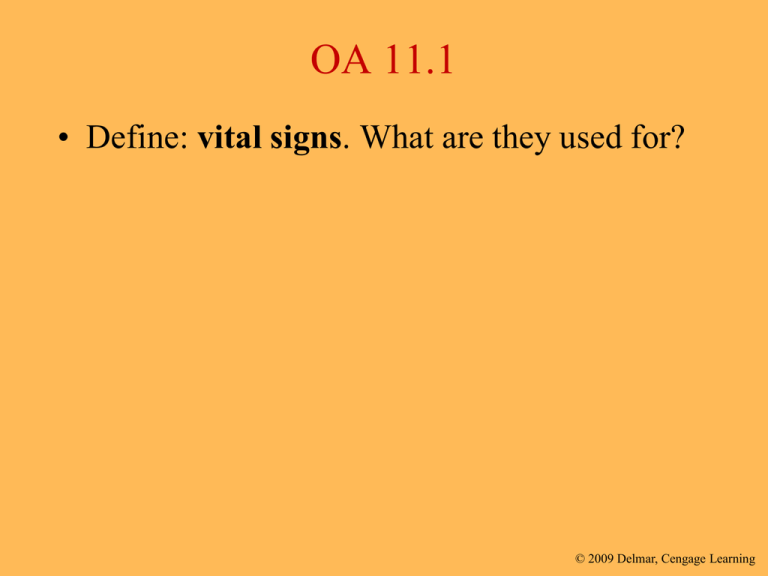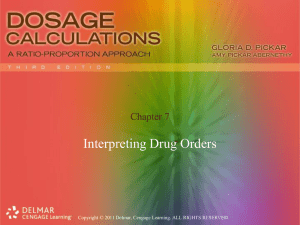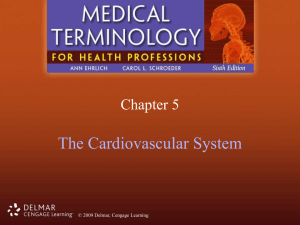continued
advertisement

OA 11.1 • Define: vital signs. What are they used for? © 2009 Delmar, Cengage Learning Chapter 15 Vital Signs © 2009 Delmar, Cengage Learning 15:1 Measuring and Recording Vital Signs (VS) • Record information about the basic body conditions – Abnormalities from homeostasis • Main vital signs (VS) – – – – Temperature Pulse Respiration Blood pressure © 2009 Delmar, Cengage Learning Other Assessments • Pain—patients asked to rate on scale of 1 to 10 (1 is minimal and 10 is severe) © 2009 Delmar, Cengage Learning Other Assessments • Color of skin – – – – – Pallor Cyanosis Jaundice Erythema Ecchymosis © 2009 Delmar, Cengage Learning Other Assessments • Size of pupils and reaction to light © 2009 Delmar, Cengage Learning Other Assessments • Level of consciousness © 2009 Delmar, Cengage Learning Other Assessments • Response to stimuli © 2009 Delmar, Cengage Learning VS Readings • Accuracy is essential – Must know how to accomplish task with various equipment – Never guess or report false readings • Report abnormality or change – Severe abnormalities indicate life-threatening conditions • If unable to get reading, ask another person to check © 2009 Delmar, Cengage Learning OA 11.4 • What information can be gathered from measuring vital signs? © 2009 Delmar, Cengage Learning 15:2 Measuring and Recording Temperature • Measures balance between heat lost and heat produced in the body – Thermal activity • Heat produced by metabolism of food and by muscle and gland activity • Heat lost through perspiration, respiration, and excretion © 2009 Delmar, Cengage Learning 15:2 Measuring and Recording Temperature • Conversion between Fahrenheit and Celsius temperature F C: C = (F-32) x 0.5556 C F: F = (C x 9/5) + 32 • Practice: – 102o F to C – 19o C to F 212o F to C 37o C to F © 2009 Delmar, Cengage Learning Variations in Body Temperature • Normal range – 97-100o F, 36.1-37.8o C • Causes of variations – Size/shape of individual, time of day, part of body, metabolic activity © 2009 Delmar, Cengage Learning Variations in Body Temperature • Temperature measurements — oral, rectal (often used on infants/children), axillary or groin, aural, and temporal • Normal: – Oral: 98.6o F – Rectal: 99.6o F Axillary: 97.6o F Aural/Temporal: no normal range © 2009 Delmar, Cengage Learning Variations in Body Temperature Abnormal conditions affecting temperature Increase: • Illness and infection • Exercise, excitement, fear • High environmental temperatures Decrease: • Starvation or fasting • Sleep • Sedation • Mouth breathing • Cold environmental temperatures © 2009 Delmar, Cengage Learning Variations in Body Temperature • Abnormal conditions – Hypothermia: body temperature < 95o F – Fever: elevated above 101o F • Pyrexia, Febrile, Afebrile – Hyperthermia: body temperature > 104o F © 2009 Delmar, Cengage Learning Thermometers • Clinical thermometers – – – – – Glass: contains mercury, analog Electronic: digital reading, quicker results Tympanic: use infrared energy Temporal: measures temporal artery Plastic or paper: disposable • Reading thermometers and recording results – Read in 1o increments, labeled by site • R, Ax, Gr, A (continues) © 2009 Delmar, Cengage Learning © 2009 Delmar, Cengage Learning Thermometers (continued) • Avoid factors that could alter or change temperature – Examples??? • Cleaning thermometers – Clean with alcohol wipe or soap/water • Paper/plastic sheath on glass thermometer – Used to prevent transmission of disease – Dispose of properly © 2009 Delmar, Cengage Learning OA 11.5 • List 3 factors that would affect your body temperature right now. © 2009 Delmar, Cengage Learning 15:3 Measuring and Recording Pulse • Pressure of the blood pushing against the wall of an artery as the heart beats and rests (continues) © 2009 Delmar, Cengage Learning 15:3 Measuring and Recording Pulse • Major arterial or pulse sites – – – – – – – Temporal Carotid Brachial Radial Femoral Popliteal Dorsal Pedal (continues) © 2009 Delmar, Cengage Learning 15:3 Measuring and Recording Pulse • • • • Must note 3 different factors of the pulse: Pulse rate Pulse rhythm Pulse volume (continues) © 2009 Delmar, Cengage Learning 15:3 Measuring and Recording Pulse • Pulse rate – adult 60-80 bpm, varies – Bradycardia: slow pulse rate, < 60 bpm – Tachycardia: fast pulse rate, >100 bpm • Pulse rhythm – spacing between beats – Regular vs. irregular – Arrythmia: abnormal heart rhythm • Pulse volume – strength/intensity of the pulse – Strong vs. weak, thready, bounding (continues) © 2009 Delmar, Cengage Learning Measuring and Recording Pulse Factors that change pulse rate Increased: • Exercise • Stimulant drugs • Excitement • Fear • Fever • Shock • Nervous tension Decreased: • Sleep • Depressant drugs • Heart disease • Coma • Physical training © 2009 Delmar, Cengage Learning Measuring and Recording Pulse (continued) Basic principles for taking radial pulse: 1. Patient positioned comfortably, palm down 2. Use tip of index/middle fingers to locate pulse on thumb side of wrist 3. First beat counted starts with zero 1. 2. 3. 4. 10 sec x 6 15 sec x 4 30 sec x 2 60 sec © 2009 Delmar, Cengage Learning Measuring and Recording Pulse (continued) • Recording information: – Include rate, rhythm, volume © 2009 Delmar, Cengage Learning 15:4 Measuring and Recording Respirations • Measures the breathing of a patient • Process of taking in oxygen and expelling carbon dioxide from the lungs and respiratory tract (continues) © 2009 Delmar, Cengage Learning 15:4 Measuring and Recording Respirations • One respiration: one inspiration (breathing in) and one expiration (breathing out) (continues) © 2009 Delmar, Cengage Learning Measuring and Recording Respirations (continued) • Normal respiratory rate – Adults: 12-20 breaths per minute – Children: 16-25 per minute – Infants: 30-50 per minute © 2009 Delmar, Cengage Learning Measuring and Recording Respirations (continued) • Character of respirations – refers to depth and quality – Deep vs. shallow, labored, moist, difficult, noisy • Rhythm of respirations – refers to spacing between breaths – Regular (or even) vs. irregular © 2009 Delmar, Cengage Learning Measuring and Recording Respirations (continued) • Abnormal respirations – Dyspnea: difficulty breathing – Apnea: absence of respirations – Tachypnea: rapid, shallow > 25/min – Bradypnea: slow <10/min © 2009 Delmar, Cengage Learning Measuring and Recording Respirations (continued) • Abnormal respirations – Orthopnea: severe dyspnea in any position besides sitting or standing – Cheyne-Stokes: abnormal breathing pattern, periods of dyspnea and apnea – Rales: bubbling or noisy sounds caused by fluid © 2009 Delmar, Cengage Learning Measuring and Recording Respirations (continued) • Voluntary control of respirations – Respiration can be controlled if consciously thought about – Important to keep the patient unaware breathing is being assessed – Do not tell the patient you are counting respirations © 2009 Delmar, Cengage Learning Measuring and Recording Respirations (continued) • Record information – Rate, character, rhythm • Ex: A child with R 22, shallow, labored, and regular would suffer from? • Ex: An adult with R 8, deep, regular would suffer from? © 2009 Delmar, Cengage Learning 15:5 Graphing TPR • Graphic sheets are special records used for recording TPR • Presents a visual diagram (easier to follow) • Uses – hospitals or long care facilities (continues) © 2009 Delmar, Cengage Learning 15:5 Graphing TPR • Color codes – Temperature in blue – Pulse in red – Respirations in green • Factors affecting VS are often noted on the graph – Surgeries, medications, day & time, etc. (continues) © 2009 Delmar, Cengage Learning Graphing TPR (continued) • Graphic charts are legal records – – – – Must be legible and neat Completed in ink Use straightedge to connect lines HIPAA act! • To correct an error: cross out in red ink and correct, initial next to correction © 2009 Delmar, Cengage Learning Graphing TPR (continued) • Basic principles for completing: – – – – – – Fill in patient information accurately Fill in dates, times (mm/dd/yyyy, __:__am/pm) Adm = admission (first measurement) Following days are numbered PO/PP = after surgery PP = post partum (after delivery) © 2009 Delmar, Cengage Learning © 2009 Delmar, Cengage Learning OA 11.12 • What is blood pressure? © 2009 Delmar, Cengage Learning 15:7 Measuring and Recording Blood Pressure • Measurement of the pressure the blood exerts on the walls of the arteries during the various stages of heart activity • Measured in millimeters of mercury (mmHg) on a sphygmomanometer (continues) © 2009 Delmar, Cengage Learning Measuring and Recording Blood Pressure (continued) • Systolic pressure: pressure when left ventricle contracts – Normal is <120 mmHg (range of 100-120 mmHg) – First sound heard during reading of sphygmomanometer © 2009 Delmar, Cengage Learning Measuring and Recording Blood Pressure (continued) • Diastolic pressure: constant pressure when left ventricle relaxes – Normal is < 80 mmHg (range of 60-80 mmHg) – Last sound heard during reading of sphygmomanometer © 2009 Delmar, Cengage Learning Measuring and Recording Blood Pressure (continued) • Blood pressure is read as a fraction • Systolic pressure / Diastolic pressure – Ex: (120/80 mmHg) © 2009 Delmar, Cengage Learning Measuring and Recording Blood Pressure (continued) • Pulse pressure: difference between systolic & diastolic pressure – Important indicator of health and tone of arterial walls – Normal range is 30-50 mmHg © 2009 Delmar, Cengage Learning Measuring and Recording Blood Pressure (continued) • Hypertension—high blood pressure – Prehypertension (120-139 mmHg / 80-89 mmHg) – Systolic >140 mmHg / Diastolic >90 mmHg • Hypotension—low blood pressure – Systolic <90 mmHg / Diastolic <60 mmHg (continues) © 2009 Delmar, Cengage Learning Measuring and Recording Blood Pressure (continued) • Factors influencing blood pressure readings (high or low) – – – – – Force of heartbeat Resistance of arterial system Elasticity of the arteries Volume of blood in arteries Position of the patient (standing vs sitting vs lying down) (continues) © 2009 Delmar, Cengage Learning Measuring and Recording Blood Pressure Increased BP (continued) • Excitement, anxiety, nervous tension • Pain • Obesity • Stimulant drugs • Exercise and eating • Smoking • • • • • • Decrease BP Rest or sleep Depressant drugs Shock Dehydration Hemorrhage fasting © 2009 Delmar, Cengage Learning Measuring and Recording Blood Pressure (continued) • Types of sphygmomanometers – Mercury: uses a column of mercury in a tube to measure the pressure (discouraged by OSHA) – Aneroid: uses a round gauge to measure pressure • Each line on gauge = 2 mmHg • Measure at eye level, deflated cuff should read zero – Electronic: measures pressure automatically • Shows reading on a digital display (continues) © 2009 Delmar, Cengage Learning © 2009 Delmar, Cengage Learning Measuring and Recording Blood Pressure (continued) • Factors to follow for accurate readings – Patient should sit quietly for at least five minutes before BP is taken – Two readings should be taken and averaged • Minimum wait of 30 seconds between readings – Arm should be rested on a flat surface & free of restrictions © 2009 Delmar, Cengage Learning Measuring and Recording Blood Pressure (continued) • How to measure blood pressure – Cuff should be placed above the crook of the elbow, with arrow pointing over brachial artery – Place the bell/diaphragm of stethoscope directly over brachial artery in the antecubital fossa • Hold as securely as possible with index/middle fingers – Inflate cuff to 150-180 mmHg – Deflate slowly and listen for heart sounds © 2009 Delmar, Cengage Learning © 2009 Delmar, Cengage Learning © 2009 Delmar, Cengage Learning Measuring and Recording Blood Pressure (continued) • Record all required information – Date, time, BP, signature/initials • Do not discuss the reading with the patient; it’s the doctor’s responsibility – Could cause personal reaction to patient © 2009 Delmar, Cengage Learning





